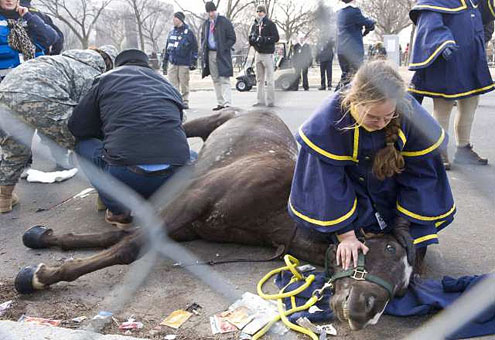
By Jennifer Forsberg Meyer
From Horse & Rider magazine
What to do if your horse becomes ill or gets injured out on a trail ride.
You’re riding out yonder, far from help, when your horse gets hurt or sick. What do you do? We asked David Turoff, DVM, of Foothill Mobile Veterinary Service in Placerville, Calif., whose expertise includes large-animal rescue. Here’s his advice:
DO dismount, get your horse under some shade, and remove your saddle. Then, assess the situation and your options while doing your best to stay calm.
DO administer first aid if you know how and have the necessary items; a riding companion may have what you don’t. (See “Carry-Along Kit,” below.)
DON’T leave your horse alone on the trail, if at all possible. A horse tied or tethered on his own is waiting to panic. (Horses, being herd animals, are hardwired to stay with a group to avoid being targeted by predators.)
DO summon help. Use your cell phone if you have service. If you don’t, send someone to retrieve help. (If there are only two of you on the ride, be aware that your horse may become anxious when the other horse leaves.) If where you are, or can reasonably get to (more on that in a moment), isn’t accessible by automobile, have the person who goes for help arrange to find a horse or an all-terrain vehicle the veterinarian can use to reach you. If you have a GPS unit, note your location, then send the unit with the person who rides for help, so the returning party can use it to find you.
DO try to lead your horse closer to where help will be IF: you’re many miles from the nearest vehicle access, there’s plenty of daylight left, and your horse is capable of moving (he has, say, a laceration that’s stopped bleeding and won’t hinder his movement). Be sure the person going for help knows where you’re headed. On the other hand…
DON’T try to move your horse IF: help is reasonably close and can drive to where you are, dark is coming on, or your horse is too sick or wounded to move. Above all, don’t push the panic button, even if the situation seems dire. Your horse needs you to remain calm and in control, and so do your companions.
Before-The-Ride-Checklist
Advance planning will pay huge dividends in the event you do run into trouble on the trail. Here’s what Dr. Turoff recommends:
* Don’t ride alone. With three or more in your party, there’s someone to go for help and someone to stay with the ill/injured horse and his rider. But even one other companion is vastly better than riding alone.
* Do carry a cell phone with your vet’s number (and a backup) preprogrammed into it. A GPS unit can also be extremely helpful, and will work in places where cell phones won’t.
* Always tell someone where your group is going and when you expect to be back.
* Familiarize yourself with some of the road access points and parking areas around where you’ll be going. (Where an injury occurs may be closer to one of the alternate access points than where you started.)
* Ensure that someone in your party brings a basic first-aid kit. (See “Carry-Along Kit,” below.) Keep a more complete kit in your trailer.
Carry-Along Kit
* Wire cutters and pliers, or a multipurpose tool (such as a Leatherman®) that includes these functions.
* Emergency boot (such as Easyboot or Pro Fit) in case a shoe is thrown. (Each rider should carry his own, in a size to fit his/her horse.)
* Two sterile, non-stick, 4″ x 8″ pads.
* One leg quilt.
* One roll 3- or 4-inch soft roller gauze.
* One roll 3- or 4-inch Elastikon® tape.
* Water-soluble antiseptic ointment (such as Neosporin®).
* Two 8-inch lengths of 1/2-inch garden hose, fire-polished on the ends, plus K-Y® jelly or similar lubricant for snakebite complications; see “What Might Happen (& What To Do),” below.
* Clean hand towel.
* Tube Banamine® or phenylbutazone paste.
* Two 10-inch lengths of 1-inch Velcro® strapping (available at hardware stores), for splinting and other binding purposes. You can also use these straps to hold your other first-aid items together.
What Might Happen (& What To Do)
* Lameness from a fall, twisted joint, or hoof puncture/injury. Allow horse to rest.
* Laceration from a fall or spook. Wash dirt/debris out of wound; stop or minimize bleeding by applying direct pressure with clean towel; bandage the wound with material from first-aid kit.
* Colic, brought on by slight dehydration and/or stress, unfamiliar forage. Allow horse to rest; administer Banamine® or bute paste if pain becomes severe.
* Tying up (stiffness and reluctance to move with no obvious cause; pain-response when you press on croup muscles; dark, sludgy urine). Allow horse to rest; any movement will make matters worse.
* Snakebite. Allow horse to rest. If swelling from a bite on the muzzle begins to compromise breathing, lubricate the lengths of two 8-inch garden hoses in your first-aid kit and insert them into horse’s nostrils.
This article originally appeared in the August 2009 issue of Horse & Rider magazine.
